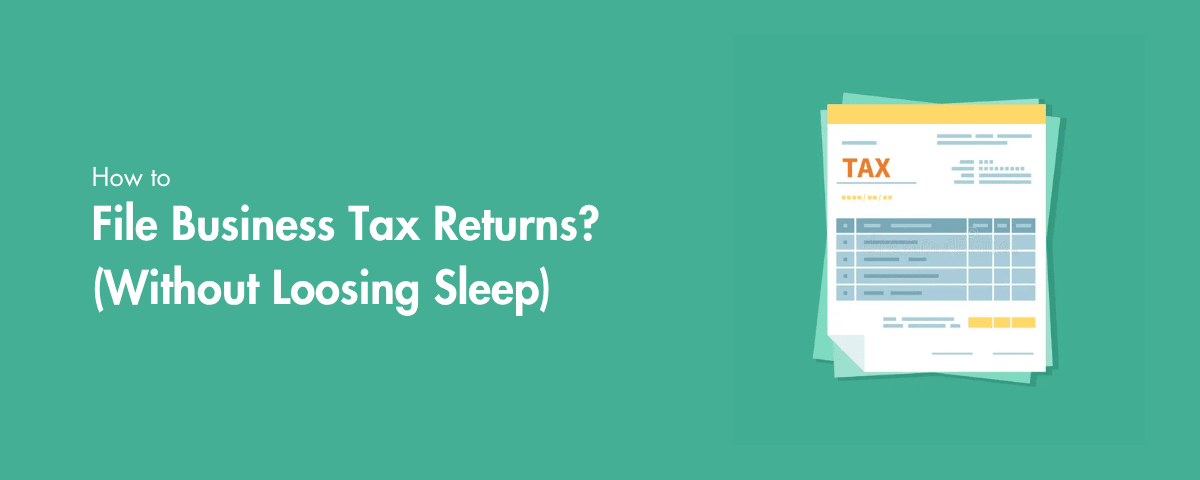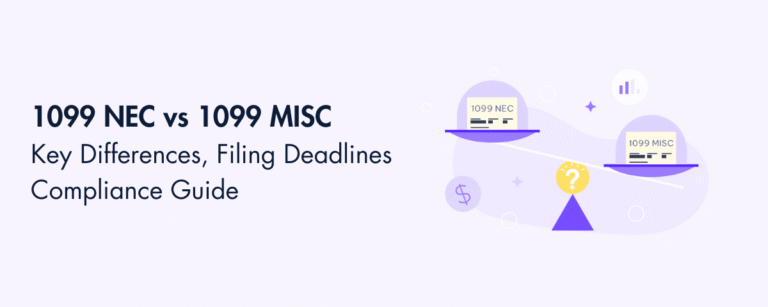A client walked in with three shoeboxes, one for receipts, one for 1099s, and one labeled “mystery.” You might laugh, but if you are juggling sales, payroll, and year‑end forms, it is easy for details to slip.
The good news, you do not need perfect books to file on time. You need a clear game plan, the right forms, and a simple checklist you can repeat every year.
This guide is written for U.S. businesses and solo owners, and it reflects 2025 filing dates for 2024 tax returns.
You will find plain‑English steps, the forms you actually need, and a few hard‑won tips from the trenches. I will call out where rules shift when a deadline falls on a weekend, and I will include quick references to the IRS so you can double‑check anything important.
If a federal deadline falls on a Saturday, Sunday, or legal holiday, it moves to the next business day. That simple rule explains a lot of the “why did my due date change this year” confusion. (irs.gov)
Table of Contents
Key Takeaways
- Pick the correct tax treatment first, sole proprietor, partnership, S corporation, or C corporation. That one choice dictates your forms and your due dates.
- Keep a tidy paper trail, income, expenses, payroll, assets, mileage, and home office, then reconcile to bank, merchant, 1099‑NEC, and 1099‑K totals before you file.
- Common federal forms by entity, Schedule C and Schedule SE, Form 1065 with K‑1s, Form 1120‑S with K‑1s, or Form 1120. Add Form 4562 for depreciation, Form 4797 for asset sales, and Form 8995 for the QBI deduction if you qualify.
- Core 2025 calendar items for calendar‑year filers, partnerships and S corps returns are due Monday, March 17, 2025, since March 15 is a Saturday. C corps and Schedule C filers are due Tuesday, April 15, 2025. If you extend, entities get six months with Form 7004 and individuals use Form 4868, payments are still due on the original dates.
- Keep records at least three years, and payroll tax records at least four years after the tax is due or paid, whichever is later. E‑file and pay electronically when possible for speed and fewer errors. (irs.gov)
What You Need to Confirm First
Identify your business structure and tax treatment
- Sole proprietor or single‑member LLC taxed as disregarded, you file Schedule C with your Form 1040, plus Schedule SE if net earnings are at least 400 dollars.
- Partnership or multi‑member LLC taxed as a partnership, you file Form 1065 and issue K‑1s.
- S corporation, you file Form 1120‑S and issue K‑1s to shareholders.
- C corporation, you file Form 1120. These due‑date rules come from the IRS tax calendar, which also explains how weekends and legal holidays shift dates. (irs.gov)
Get an EIN if required
You need an EIN if you have employees, operate as a partnership or corporation, or must file certain returns, like employment taxes. The IRS issues EINs for free, and you can apply online. (irs.gov)
Know your payroll and FUTA basics
If you have employees, plan for quarterly payroll returns and an annual FUTA return. Form 941 or 944 handles federal income tax withholding and FICA, and Form 940 covers FUTA. Form 940 is due January 31, with an extra time allowance to February 10 if you deposited all FUTA tax on time. (irs.gov)
A Step‑by‑Step Plan That Works
Think of your filing process like a pre‑flight checklist. You set up your entity and EIN, reconcile the books, choose the right forms, then file, pay, and archive.
Step 1, Reconcile all income
- Pull business bank statements and merchant processor summaries.
- Match totals to your books and to every 1099‑NEC and 1099‑K you received.
- Investigate gaps early, for example, platform fees or timing differences can create small but annoying variances.
Micro‑tip, the biggest mismatch I see each February is a missing 1099‑K from a payment app that was tied to a personal email. Add a line to your year‑end checklist, “Confirm 1099‑K emails and logins.”
Step 2, Organize deductible expenses
Sort receipts and invoices by category, rent, utilities, supplies, software, insurance, advertising, professional fees, travel, and meals. Keep a mileage log, track business use percentages, and gather home office square footage and cost details if you claim it.
Add asset invoices and serial numbers so you can claim depreciation on Form 4562 and record any sales on Form 4797. Keep everything that supports a number on your return. The IRS guidance on recordkeeping is clear, keep business records long enough to support what you reported, generally three years, with four years for employment tax records. (irs.gov)
Step 3, Confirm your forms and schedules
- Schedule C and Schedule SE for sole proprietors and single‑member LLCs taxed as disregarded entities.
- Form 1065 with K‑1s for partnerships.
- Form 1120‑S with K‑1s for S corps.
- Form 1120 for C corps. Add Form 8995 for the qualified business income deduction when you qualify, Form 4562 for depreciation and Section 179, and Form 4797 if you sold business property.
Step 4, E‑file securely and keep proof
Use an IRS‑authorized business e‑file provider. E‑file reduces transcription errors and speeds acknowledgments. If you are a tax pro or plan to e‑file for clients, apply to become an authorized e‑file provider and obtain an EFIN. (irs.gov)
Step 5, Archive and back up
Keep copies of filed returns, acknowledgments, K‑1s, 1099s, bank statements, payroll reports, mileage logs, and depreciation schedules. Keep them for at least three years, and keep employment tax records at least four years after the tax is due or paid. Store a secure digital backup and restrict access.
When to get help
If you are behind on reconciliations, dealing with K‑1s, or handling multi‑state issues, bring in a CPA or EA. If you lead a CPA or EA firm and your internal team is at capacity, Accountably can support your back office, reconciliations, and K‑1 processing, so your firm stays timely and compliant without rushing.
Choose the Right Forms and Schedules
Rule of thumb, match your entity to its core return, then add schedules for payroll, depreciation, asset sales, and the QBI deduction where they apply.
Quick comparison table
| Entity type | Core federal return | Owners’ pass‑through form | Typical add‑ons |
| Sole proprietor, single‑member LLC taxed as disregarded | Schedule C, with your Form 1040 | Schedule SE if net earnings at least 400 dollars | 4562 for depreciation, 4797 for asset sales, 8995 for QBI |
| Partnership or multi‑member LLC taxed as partnership | Form 1065 | Schedule K‑1 to each partner | 4562, 4797, 8995 where eligible |
| S corporation | Form 1120‑S | Schedule K‑1 to each shareholder | 4562, 4797, 8995 where eligible |
| C corporation | Form 1120 | None, dividends reported by shareholders | 4562, 4797 |
Note, the IRS sets these forms by statute and instructions. The exact due date depends on your tax year and the weekend or holiday adjustment. (irs.gov)
Sole proprietors, Schedule C essentials
- Include all gross receipts, including platform sales paid through 1099‑K.
- Separate cost of goods sold from operating expenses.
- If your net earnings are at least 400 dollars, compute self‑employment tax on Schedule SE and remember that half of SE tax is deductible above the line.
Partnerships and LLCs taxed as partnerships, Form 1065
- Report income and deductions at the entity level, then issue K‑1s.
- Keep capital account details current and consistent.
- Calendar‑year partnerships file in March, and when March 15 falls on a Saturday, the due date moves to Monday, March 17, 2025, for the 2024 year. Extensions add six months with Form 7004.
S corporations, Form 1120‑S
- Report activity at the entity, issue K‑1s, and pay reasonable wages to owner‑employees through payroll.
- Calendar‑year S corps follow the same March timeline, due Monday, March 17, 2025, since March 15 is a Saturday. File Form 7004 for a six‑month extension if you need more time.
C corporations, Form 1120
- Calendar‑year C corps file by the 15th day of the fourth month, Tuesday, April 15, 2025, for 2024 returns. Extensions come through Form 7004. (irs.gov)
Common schedules you might add
- Form 4562, depreciation and Section 179 on equipment and certain improvements.
- Form 4797, gains and losses from selling business property.
- Form 8995, the qualified business income deduction if your business and income level qualify.
Estimated taxes you should plan for
- If you expect to owe 1,000 dollars or more with your individual return, make quarterly estimated payments using Form 1040‑ES. Payments are due on the 15th day of the fourth, sixth, and ninth months, and the 15th day of the first month of the next year. If a date falls on a weekend or holiday, it moves to the next business day. That means for 2025, Q2 lands Monday, June 16, 2025, since June 15 is a Sunday. (irs.gov)
Payroll and FUTA highlights you cannot skip
- File Form 941 quarterly or Form 944 annually if the IRS notifies you to use it.
- Deposit payroll taxes electronically using EFTPS.
- File Form 940 for FUTA by January 31, or by February 10 if you deposited all FUTA taxes on time. (irs.gov)
E‑filing and security basics
Use an approved Modernized e‑File business provider. If you prepare and transmit returns for clients, you will need to apply for authorization and receive an EFIN. The IRS explains roles like Electronic Return Originator and Transmitter, and the application is completed online. (irs.gov)
Pro tip, do not transmit returns before you have all wage and income forms in hand. Authorized e‑file providers are prohibited from submitting returns before receiving required forms such as W‑2. (irs.gov)
Your Filing Workflow, Start to Finish
Phase 1, Prep and reconcile
- Recreate the year in a single spreadsheet if your books are messy. One tab for income sources, one for expenses, one for assets and loans.
- Tie gross sales to 1099‑NEC and 1099‑K totals and to your bank statements. Mark any platform fees or refunds that explain differences.
- Collect payroll reports, W‑2s, W‑3, quarterly 941s or annual 944, state unemployment reports, and EFTPS confirmations.
Small gaps snowball under deadline pressure. If a number does not tie, write a short note about the cause, then move on.
Phase 2, Choose forms and prepare returns
- Sole proprietor, complete Schedule C with categories that match your books, then complete Schedule SE if needed.
- Partnership, complete Form 1065, attach statements where required, and generate K‑1s for every partner, even for partial‑year partners.
- S corporation, complete Form 1120‑S, maintain basis and reasonable compensation records, and issue K‑1s to shareholders.
- C corporation, complete Form 1120 and compute any estimated tax safe harbor for the current year.
Phase 3, E‑file and pay
- E‑file your return using an IRS‑approved provider, keep the acknowledgment in your archive, and use IRS Direct Pay, EFTPS, or your Business Tax Account to pay securely. The IRS keeps an approved list of business e‑file providers and explains how the Modernized e‑File system works. (irs.gov)
- If you cannot finish by the original due date, file an extension, individuals use Form 4868, pass‑throughs and corporations use Form 7004. Remember, extensions give you more time to file, not more time to pay. (irs.gov)
Phase 4, Archive and future‑proof
- Keep copies of filed returns, e‑file acknowledgments, payroll filings, bank statements, 1099s, K‑1s, receipts, and mileage logs.
- Keep records for at least three years, and employment tax records for at least four years after the tax is due or paid. Set a recurring calendar reminder to purge and re‑organize each summer. (irs.gov)
2025 Due Dates at a Glance, Calendar‑Year Filers
- Partnerships, Form 1065, due Monday, March 17, 2025, because March 15 is a Saturday. Extended returns due Monday, September 15, 2025. (irs.gov)
- S corporations, Form 1120‑S, due Monday, March 17, 2025. Extended returns due Monday, September 15, 2025. (irs.gov)
- Individuals and sole proprietors filing Schedule C with Form 1040, due Tuesday, April 15, 2025. If you extend with Form 4868, the final deadline is Wednesday, October 15, 2025. (irs.gov)
- C corporations, Form 1120, due Tuesday, April 15, 2025, for calendar‑year corporations. If extended with Form 7004, the final deadline is Wednesday, October 15, 2025. (irs.gov)
- 2025 individual estimated tax payments, Q1 due April 15, 2025, Q2 due Monday, June 16, 2025, Q3 due Monday, September 15, 2025, and Q4 due Thursday, January 15, 2026. These dates follow the “15th day, next business day if weekend or holiday” rule. (irs.gov)
Note, disaster relief can shift deadlines in affected areas. Always check the IRS disaster page for current relief guidance.
Common Pitfalls and How to Avoid Them
Mismatched income totals
If your 1099‑K shows gross volume that does not match your books, check whether your accounting treats processor fees as expenses rather than netting them against income. Reconcile at the gross level first, then account for fees.
Missing depreciation schedules
If you bought equipment or placed improvements in service, you likely need Form 4562. Keep invoices with serial numbers and service dates. If you disposed of assets, record the sale on Form 4797, even if the proceeds were small.
Payroll deposits not made electronically
Federal tax deposits must be electronic. Set up EFTPS and schedule deposits as soon as you run payroll. Publication 509 and the FUTA guidance spell out deposit rules and the electronic requirement. (irs.gov)
Confusing EIN rules
If you incorporated or formed an LLC, you generally need an EIN. The IRS issues EINs for free, apply online. No need to pay a third party. (irs.gov)
If you are a CPA or EA leading a firm, and your backlog spikes during March and September, Accountably can extend your team with offshore staffing and back‑office support so you deliver on time without burning out your staff.
FAQs
How do I file business taxes if I just started?
Confirm your entity and whether you need an EIN, then set up simple bookkeeping and a folder for receipts. For your first year, keep a running list of income sources and expense categories, then pick the form that matches your structure, Schedule C, 1065, 1120‑S, or 1120. If you cannot finish by the original due date, file an extension, pay what you estimate you owe, then finalize with clean records. (irs.gov)
Can I file business taxes myself?
Yes, many owners self‑prepare using reputable software, especially sole proprietors with straightforward books. If you have partners, payroll, multi‑state sales, or asset sales, consider a professional review. Either way, e‑file and keep a full archive, it saves time if the IRS asks questions later. (irs.gov)
How much income triggers a filing requirement for a sole proprietor?
If your net self‑employment earnings are at least 400 dollars, you must file and compute self‑employment tax on Schedule SE. That threshold catches many new businesses even if profit was modest. Plan for quarterly estimates if you expect to owe 1,000 dollars or more for the year.
How do extensions work?
Extensions move the filing deadline, not the payment deadline. Individuals use Form 4868 and most entities use Form 7004 to request six months. Pay what you reasonably expect to owe by the original due date to avoid penalties and interest. (irs.gov)
How long should I keep business records?
Keep tax records long enough to support items on your return, generally three years, and keep employment tax records at least four years after the tax is due or paid. Asset records often need to be kept longer so you can compute gain or loss when you sell. (irs.gov)
A Simple Checklist You Can Reuse
- Confirm entity and tax treatment.
- Get or confirm your EIN, and verify bank and processor info. (irs.gov)
- Reconcile income to bank, merchant statements, and all 1099s.
- Organize expenses, payroll, assets, mileage, and home office.
- Pick the right forms, Schedule C and SE, 1065 with K‑1s, 1120‑S with K‑1s, or 1120, plus 4562, 4797, and 8995 as needed.
- E‑file using an approved provider, and pay electronically. (irs.gov)
- Calendar quarterly estimates and filing extensions if needed.
- Archive returns, acknowledgments, and supporting documents, three years minimum, four for payroll. (irs.gov)
Final Notes, Timing and Trust
- 2025 calendar highlights, partnerships and S corps due Monday, March 17, 2025, individuals and C corps due Tuesday, April 15, 2025. If you extend, partnerships and S corps due Monday, September 15, 2025, individuals and C corps due Wednesday, October 15, 2025. These dates follow the IRS tax calendar and weekend rules. (irs.gov)
- Pay online when possible, through IRS Direct Pay, EFTPS, or your Business Tax Account, and choose an IRS‑approved e‑file provider to reduce errors and speed acknowledgments. (irs.gov)
If you are a business owner, consider working with a CPA or EA. If you are a CPA, EA, or accounting firm leader, and your team is stretched thin, Accountably can step in with offshore staffing and back‑office solutions so reconciliation, K‑1 processing, and extensions stay on track while you maintain compliance. Use us sparingly where it helps you deliver great client work.
Disclaimer and editorial standards
This guide is educational and does not replace advice from your own tax professional. Reviewed for accuracy as of October 4, 2025, using IRS primary sources for key dates and rules referenced above.







